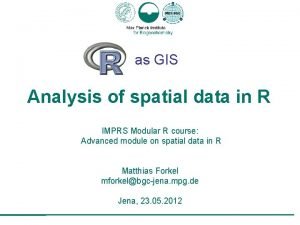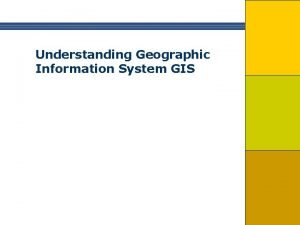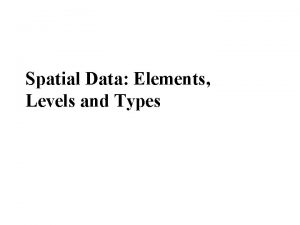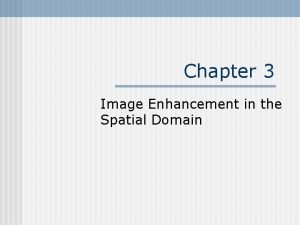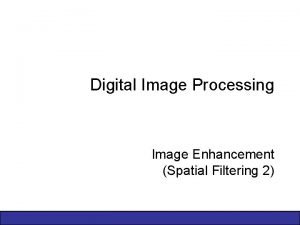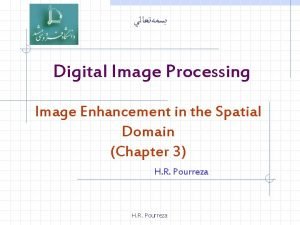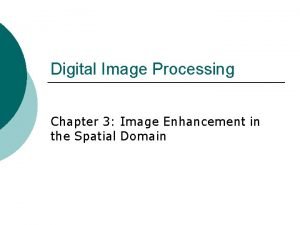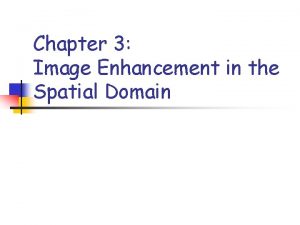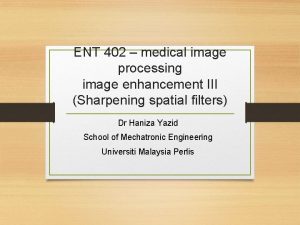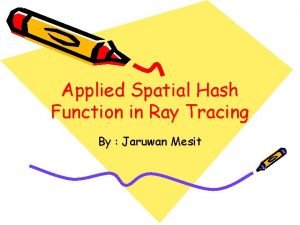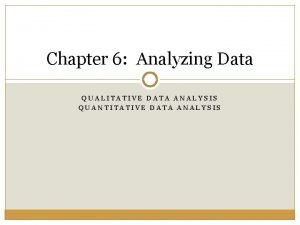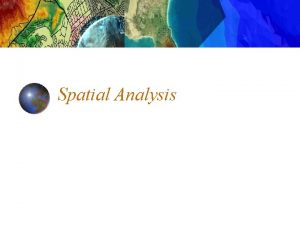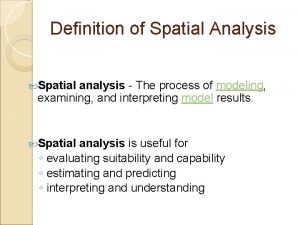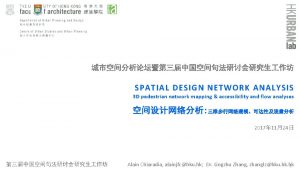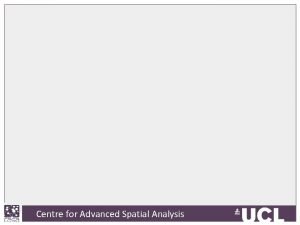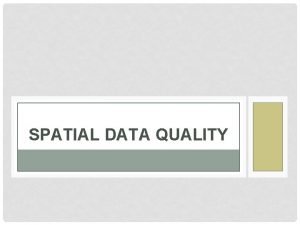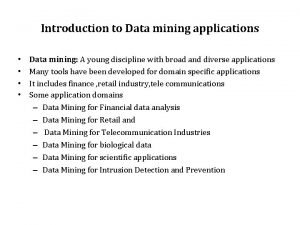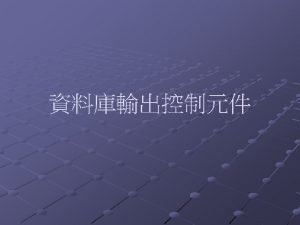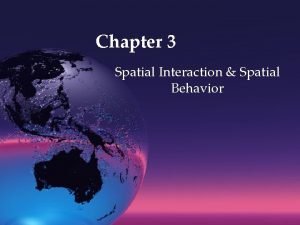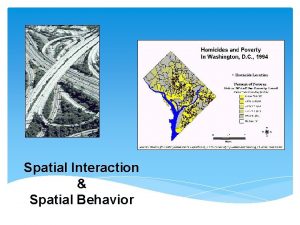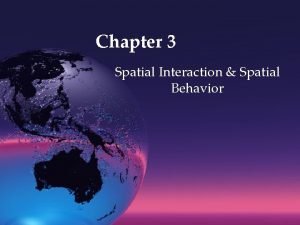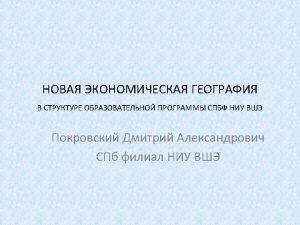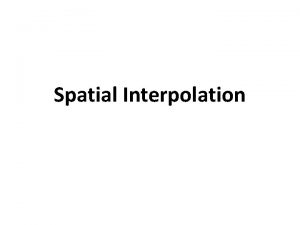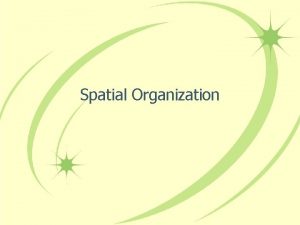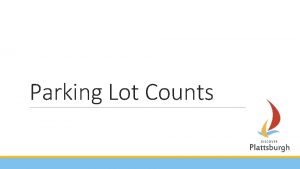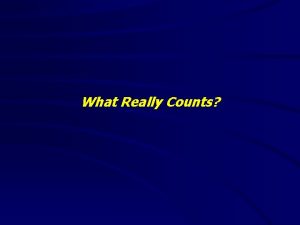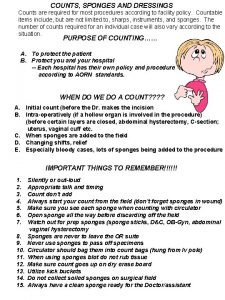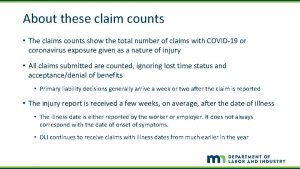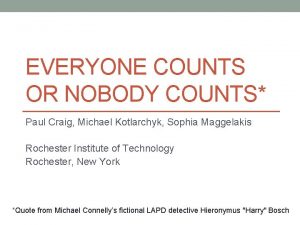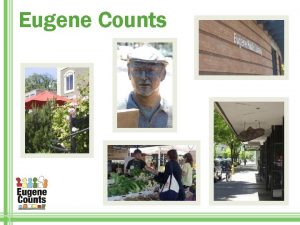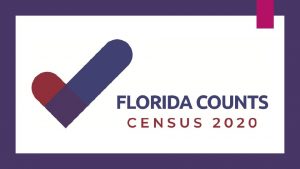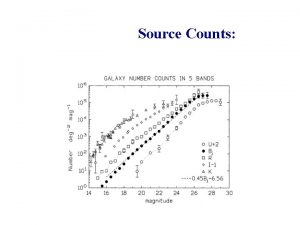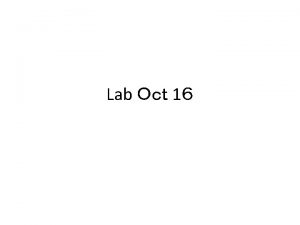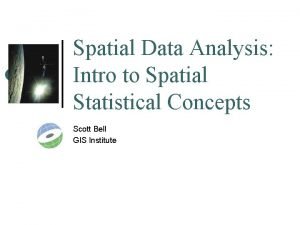Spatial Analysis Grid cell counts Grid Methods Data









![opar <- par(mfrow=c(2, 2), mar=c(0, 0, 0, 0)) plot(SPUnits, col=Colors[as. numeric(TCt. Grp 1)]) text(985, opar <- par(mfrow=c(2, 2), mar=c(0, 0, 0, 0)) plot(SPUnits, col=Colors[as. numeric(TCt. Grp 1)]) text(985,](https://slidetodoc.com/presentation_image_h/ae929d6355add7e9209908308d7967f5/image-10.jpg)










- Slides: 20

Spatial Analysis Grid cell counts

Grid Methods • Data are recorded as coming from a particular area, but we do not have exact coordinates • Screened artifacts from an excavation unit, census data (population counts from survey tracts, incidence of disease or other characteristic

Spatial Clusters • Null hypothesis is that the data are distributed according to a Poisson distribution • Variance/mean ratio (VMR) provides a rough indication of clustering where VMR = 1 is a Poisson distribution, <1 is regular and >1 clustered

Visualizing Counts • Choropleth maps represent quantity or category by shading polygons • Dot density maps represent quantity/density by randomly or regularly spaced symbols within the polygon

Package sp • Definitions for spatial objects • Spatial. Polygons are an object that contains a set of places (e. g. grid cells, states, counties) each of which can include multiple polygons and/or holes • Perfect for choropleth and dot density maps

# Create a Spatial Polygons object source("Grid. Units 3 a. R") # Append first line of coordinates to the bottom so # first-coord = last-coord Quads <- lapply(Quads, function(x) rbind(x, x[1, ])) # Load package sp for spatial classes library(sp) # Create Polygon list (one from each unit) Quads. List <- lapply(Quads, function(x) Polygon(x, hole=FALSE)) # Areas 3 a <- sapply(Quads. List, function(x) x@area) to get areas # Create a Polygons list Units <- lapply(1: 20, function(x) Polygons(Quads. List[x], Unit. Lbl[x])) # Create a Spatial Polygons list SPUnits <- Spatial. Polygons(Units, 1: 20) # sapply(1: 20, function(x) SPUnits@polygons[[x]]@area) # to get areas from Spatial. Polygons

opar <- par(mfrow=c(2, 2), mar=c(0, 0, 0, 0)) plot(SPUnits, col=gray(1: 20/20)) plot(SPUnits, col=rainbow(20, start=0, end=4/6)) plot(SPUnits, density=c(6: 25), angle=c(45, -45)) plot(SPUnits, density=c(6: 25), angle=c(-45, 45), add=TRUE) par(opar)


# Load Flk. Size 3 a Flk. Den 3 a <- round(sweep(Flk. Size 3 a[, c("TCt", "TWgt")], 1, Flk. Size 3 a$Area, "/"), 1) Flk. Den 3 a <- data. frame(East=Flk. Size 3 a$East, North=Flk. Size 3 a$North, Flk. Den 3 a) var(Flk. Den 3 a$TCt)/mean(Flk. Den 3 a$TCt) # Cut into 4 groups TCt. Grp 1 <- cut(Flk. Den 3 a$TCt, quantile(Flk. Den 3 a$TCt, c(0: 4/4)), include. lowest=TRUE, dig=4) # TCt. Grp 2 <- cut(Flk. Den 3 a$TCt, quantile(Flk. Den 3 a$TCt, c(0: 4/4)), # labels=1: 4, include. lowest=TRUE) # TCt. Grp 3 <- cut(Flk. Den 3 a$TCt, 0: 4*1250+25, include. lowest=TRUE, # dig=4) Colors <- rev(rainbow(4, start=0, end=4/6)) Gray <- rev(gray(1: 4/4)) Hatch <- c(5, 10, 15, 20)
![opar parmfrowc2 2 marc0 0 0 0 plotSPUnits colColorsas numericTCt Grp 1 text985 opar <- par(mfrow=c(2, 2), mar=c(0, 0, 0, 0)) plot(SPUnits, col=Colors[as. numeric(TCt. Grp 1)]) text(985,](https://slidetodoc.com/presentation_image_h/ae929d6355add7e9209908308d7967f5/image-10.jpg)
opar <- par(mfrow=c(2, 2), mar=c(0, 0, 0, 0)) plot(SPUnits, col=Colors[as. numeric(TCt. Grp 1)]) text(985, 1015. 75, "Total Flakes", cex=1. 25) legend(985. 5, 1022, levels(TCt. Grp 1), fill=Colors) plot(SPUnits, col=Gray[as. numeric(TCt. Grp 1)]) text(985, 1015. 75, "Total Flakes", cex=1. 25) legend(985. 5, 1022, levels(TCt. Grp 1), fill=Gray) plot(SPUnits, angle=45, density=Hatch[as. numeric(TCt. Grp 1)]) plot(SPUnits, angle=-45, density=Hatch[as. numeric(TCt. Grp 1)], add=TRUE) text(985, 1015. 75, "Total Flakes", cex=1. 25) legend(985. 5, 1022, levels(TCt. Grp 1), angle=45, density=Hatch) legend(985. 5, 1022, levels(TCt. Grp 1), angle=-45, density=Hatch) par(opar)


library(maptools) opar <- par(mfrow=c(2, 2), mar=c(0, 0, 0, 0)) for (i in 1: 4) { dots <- dots. In. Polys(SPUnits, as. integer(round(Flk. Den 3 a$TCt/50, 0))) # 1 dot = 50 flakes plot(SPUnits, lty=0) points(dots, pch=20, col="red") polygon(c(982, 983, 984. 5, 985, 987, 986. 2, 985, 984, 983. 5, 983, 982. 7, 982. 5), c(1015. 5, 1021, 1022, 1021. 3, 1018, 1017. 6, 1017, 1016. 9, 1016. 8, 1016. 6, 1016. 3, 1016, 1015. 5), lwd=2, border="black") } par(opar) dots <- dots. In. Polys(SPUnits, as. integer(round(Flk. Den 3 a$TCt/50, 0)), f="regular") plot(SPUnits, lty=0) points(dots, pch=20, cex=. 75, col="red") polygon(c(982, 983, 984. 5, 985, 987, 986. 2, 985, 984, 983. 5, 983, 982. 7, 982. 5), c(1015. 5, 1021, 1022, 1021. 3, 1018, 1017. 6, 1017, 1016. 9, 1016. 8, 1016. 6, 1016. 3, 1016, 1015. 5), lwd=2, border="black") text(985, 1015. 75, "Total Flakes n(Each dot = 50 flakes)", cex=1. 25)



Countour Mapping • We fit a model to the data to interpolate between the observations and smooth them – Trend surface models with polynomials – Kriging – developed in geophysics to interpolate and extrapolate

library(geo. R) # load Flk. Den 3 a. RData Flk. Den 3 a$East <- Flk. Den 3 a$East +. 5 Flk. Den 3 a$North <- Flk. Den 3 a$North +. 5 Flk. Den 3 a$Av. Wgt <- Flk. Den 3 a$TWgt/Flk. Den 3 a$TCt columns <- names(Flk. Den 3 a) Flakes 3 a <- as. geodata(Flk. Den 3 a, 1: 2, 3: 5, c("TCt", "TWgt", "Av. Wgt")) Grid. Pts <- expand. grid(East=seq(982, 987, . 25), North=seq(1015. 5, 1022, . 25)) Border 3 a <- cbind(c(982, 983, 984. 5, 985, 987, 986. 2, 985, 984, 983. 5, 983, 982. 7, 982. 5), c(1015. 5, 1021, 1022, 1021. 3, 1018, 1017. 6, 1017, 1016. 9, 1016. 8, 1016. 6, 1016. 3, 1016, 1015. 5)) V <- variog(Flakes 3 a, data=Flakes 3 a$data[, "TCt"]) plot(V, type="b") vf <- variofit(V) TCt. Kv <- krige. conv(Flakes 3 a, data=Flakes 3 a$data[, "TCt"], locations=Grid. Pts, krige=krige. control(cov. pars=c(1292000, . 824))) contour(TCt. Kv, borders=Border 3 a, xlab="East", ylab="North") contour(TCt. Kv, borders=Border 3 a, axes=FALSE) contour(TCt. Kv, borders=Border 3 a, filled=TRUE) persp(TCt. Kv, borders=Border 3 a, xlab="East", ylab="North", zlab="Total Flakes", expand=. 5)




Unconstrained Clustering • Proposed by Robert Whallon • Take grid data and computer percentages (areas defined by relative abundance, not density) • Cluster grids and plot the distribution of the clusters to identify activity areas
 Oflinemaps
Oflinemaps R and gis
R and gis Spatial data and attribute data
Spatial data and attribute data Spatial data and attribute data
Spatial data and attribute data Combining spatial enhancement methods
Combining spatial enhancement methods Image processing
Image processing The objective of sharpening spatial filter is to
The objective of sharpening spatial filter is to Combining spatial enhancement methods
Combining spatial enhancement methods Combining spatial enhancement methods
Combining spatial enhancement methods Combining spatial enhancement methods
Combining spatial enhancement methods Spatial hash grid
Spatial hash grid Data analysis methods
Data analysis methods What are the inputs and outputs of system design?
What are the inputs and outputs of system design? Metal coping fpd
Metal coping fpd Spatial analysis questions
Spatial analysis questions Spatial analysis meaning
Spatial analysis meaning Spatial design network analysis
Spatial design network analysis Centre for advanced spatial analysis
Centre for advanced spatial analysis Macro level examples
Macro level examples Spatial data mining applications
Spatial data mining applications Spatial data acquisition
Spatial data acquisition

